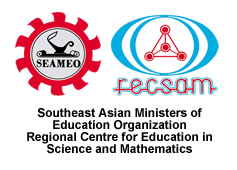Editorial Board (Issue 11 - 2016)
Chief Editor:
Nur Jahan Ahmad, PhD
Associate Editor:
Ng Khar Thoe, PhD
Review Editors:
Fazzlijan Mohamed Adnan Khan, PhD
Mohd Sazali Khalid, PhD
Thien Lei Mee, PhD
Dominador Dizon Mangao
Teh Kim Hong
Editorial Assistant: Ong Mei Yean
Contents
Anggalia Vina Evathia Ndun
Based on pre-observation, it was indicated that in learning Biology, students who were less trained to speak in front of public could not present a material confidently. This research aims at increasing Grade 8 students’ speaking skill in one of the private junior high schools in Kupang which consists of 32 students. The design of this research was classroom action research consisting of 2 cycles. The research instruments are photos, presentation rubric and journal reflection. In this research, speaking skill was expected to increase because students were trained to speak from smaller group, that was Jigsaw ‘Expert’ group then move to bigger group that was in their respective ‘Home’ group presentation.
2. Musical Mnemonics To Facilitate The Learning Of The Krebs Cycle (pp. 13-22)
Miranda P. Yeoh
This paper reports a second occasion of using music mnemonics to facilitate students’ learning. It has an added aim of improving the research design that was used by the researcher in 2012. Learning Biology requires students to master declarative knowledge and procedural knowledge. English is the medium of instruction in the matriculation college but it is not their first language. Hence, the students found it difficult to recall the Krebs cycle in English. With the use of musical mnemonics, students in the experimental group were enabled to remember the processes involved in the Krebs cycle correctly, in English, t(60) = 11.581, p = .0005. From this experimental result, the researcher posits that musical mnemonics are a useful tool to facilitate recall of this and other biological pathways, and also a tool to stimulate student interest in learning science during adolescent years. The author suggested the criteria for musical mnemonics to be effectively used to trigger memory recall of biochemical processes that require procedural knowledge. To facilitate research and the sharing of resources, a video recording of the music mnemonics was uploaded on the researcher’s contribution pages on ResearchGate, a networking site for researchers and scientists.
Ng Khar Thoe, Suma Parahakaran, Julito C. Aligaen, & Lay Yoon Fah
Education for Sustainable Development (ESD) includes an opportunity and motivation for all to be actively involved, with care for all living things considering environmental/ ecological, social and economy sustainability as well as Education for All (EFA). In response to the call for ESD/EFA, SEAMEO RECSAM has also embarked on various values-based projects/programmes and activities to promote ESD/EFA. These initiatives are in line with the aspirations of the Malaysian Ministry of Education (MOE) to promote values education as well as SEAMEO’s seven priority areas and the global ‘Sustainable Development Goals’ (SDGs). In this fifth series of the article on exemplary practices in SEARCH for youth researchers through blended learning, elaboration will be made on another sub-portal of SEARCH, entitled ‘Special Projects/programmes to Promote ESD/EFA’ (SpecP2E2). Tracer study with tracking of the milestones achieved in the endeavour of building the sustainability edge through institutional approach to promote ESD/EFA prior to and after the ‘Decade of ESD’ (DESD) from 2004 to 2014 will be reported. Evidences of exemplary practices in SEARCH for youth researchers supported by blended learning activities will be illustrated. The role of SEAMEO RECSAM as a regional training center in promoting informal science learning through various ESD/EFA related projects/programmes with exemplars will also be deliberated.
Pedro Montecillo, Jr.
Many countries in South East Asia came out among the bottom third in TIMSS 2011 and PISA 2012 in both mathematics and sciences. There is no agreement on the scope, breadth, width and content of basic education among SEAMEO member countries. Every country has different learning standards in mathematics subject. The purpose of this paper is to elaborate on the stages of drafting Southeast Asia Basic Education Standards (SEABES) Common Core Regional Learning Standards (CCRLS) in mathematics so that the countries can use this as a guide in order to benchmark with the curricula of high performing countries in the international student’s assessments as well as analyzing other international curriculum documents from countries like Singapore, South Korea and Japan. This will help to create the parallelization of the curriculum provisions across countries and learning expectations as well as learning outcomes that will enable students to contribute productively to their individual country and the region as a whole. The method used is content analysis. A mapping of the curriculum was done and many series of workshops were organized in RECSAM, Penang Malaysia. Two regional seminars were organized in RECSAM and University of Tsukuba during the last 2 years. The findings and the result will be highlighted and reported on how these documents could be used and accepted/endorsed by all SEAMEO member countries as a reference for mathematics curriculum development and revision.
Maria Melsa Arce
Programmed instruction in Chemistry was produced. The instrument used was patterned after of the work of Ticao (1986). It was face validated by jurors whilst the content and construct was validated by the teachers. Factor Analysis proved the validity of the evaluation of the programmed instruction in five Learning areas, namely: (a) Physical aspects (b) Objectives (c) Instructions, (d) Learning activities, and (e) Evaluative measures. The programmed instruction was evaluated as excellent and highly acceptable. It was tried out to one intact group of junior high school students. Results showed a fair to very satisfactory pre-and posttest scores in chemistry. Results also showed a significant difference in the pre- and post-test scores of the students. In conclusion, Programmed instruction improved junior students’ performance in Chemistry.

